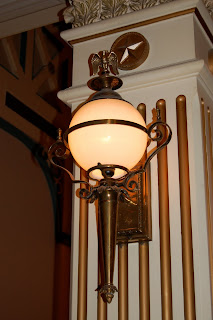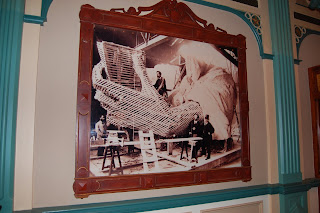In Fantasyland at Disneyland Paris, the Italian-inspired tale of Pinocchio extends well beyond the dark-ride attraction, creating an entire village of charming cottages. Located near the exit of the attraction is La Bottega di Geppetto ("bottega" is Italian for "shop," of course). Inside Geppetto's workshop, you'll find dozens of hand-carved toys and cuckoo clocks, including several examples straight from the film.
Pulled up along the side of a road near the outskirts of the village is this colorful wagon. The vendor may be offering soft pretzels by day, but a look at the door on the side of the wagon reveals who calls this his (mobile) home - Stromboli!
Around the bend, we come into the main part of the village, a collection of buildings comprising Au Chalet de la Marionnette restaurant.
Similar to the Pinocchio Village Haus at the Magic Kingdom Park, this restaurant is divided into sections representing different shops, taverns and other places in the town. The counter service area of the restaurant is more open and meant to depict the town square, with colorful tapestries strung from building to building obscuring the view of the sky.
Throughout the restaurant, artwork in the form of carvings, sculpture and murals continue to tell the story of the little wooden boy and his adventures.
Some fun bits in the artwork include the little gingerbread donkey boys in the Pleasure Island mural (above) and Figaro by the "Exit" sign (below). Fans familiar with the Village Haus Restaurant at Disneyland may know the story of how a similar "Exit" sign there was installed off center. Rather than redo it, the Imagineers on the project painted an image of Figaro the cat, pulling the sign with a rope. Here in Paris, the sign was installed correctly, and Figaro couldn't be more pleased!
The storytelling in this section of Fantasyland is really thorough, carrying details from Pinocchio into every corner. The restrooms are marked by images of tiny marionettes, and even the transition to the next land is handled with skill. Just like Peter Pan, the Pinocchio village borders Adventureland. In this case, the room of the restaurant nearest that end recalls the moments Pinocchio and his father spent in the belly of Monstro the whale. The exterior on the Adventureland side then forgoes the village look and instead resembles the outside of a wrecked ship.
























































